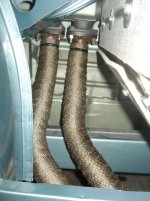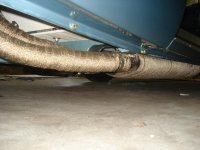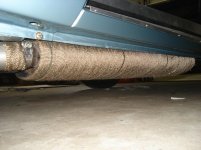First, get the car up as high as possible on jackstands (prudent safety precautions apply).
Make sure the downpipe flanges are smooth and flat--flatfile (or mill) if not. Some/all have a very slight bevel by the holes; I assume these are to allow the steel to bend a little, applying a bit of spring load against the manifold flanges--don't file/mill this away. If you happen to have the manifold out do same to it.
Make sure the studs are in good shape; if not, replace them. In my experience the SS ones are no stronger than the mild steel, but are probably less prone to corrosion.
Install the downpipes. I've seen two types of gaskets: copper and silver, perforated metal. In my experience neither work better than the other; one person I know had some solid copper ones made--presumably, that is best. Use new brass nuts; however, I've had best results using anti-seize on the studs and double-nutting steel nuts after torquing (nickel anti-seize is best for high-temp applications). Coat both sides of the gaskets with Permatex High-Temp Silicone (the copper-colored stuff). Install the front downpipe first. Torque carefully--you do not want to break a stud--and double-nut if you choose.
Then, work back from the front. The flattish, stock British-style clamps aren't great, but the American-style, bent rod type put a crimp in exhaust tubes that make removal difficult. Sealing these joints has been a long-term problem--note the modern way is flanges with a doughnut-shaped gasket. A muffler shop will usually weld most joints when fabbing an exhaust; you'll have your exhaust off again someday (trust me) so I wouldn't advise that.
Put some of the silicone on the 'male' part of the tube and insert; torque the clamps appropriately and hope for the best. Good idea to keep everything loose, then do final tightening when everything is in place and aligned.
Short of welding the joints, I don't know if it's possible to get perfect seals on every joint. If you do get them, consider yourself lucky; if not, you won't hear leaks over the usual din of a Healey (though large leaks can cause the 'popping' you sometimes get on deceleration).

 Hi Guest!
Hi Guest!

 smilie in place of the real @
smilie in place of the real @
 Pretty Please - add it to our Events forum(s) and add to the calendar! >>
Pretty Please - add it to our Events forum(s) and add to the calendar! >> 




